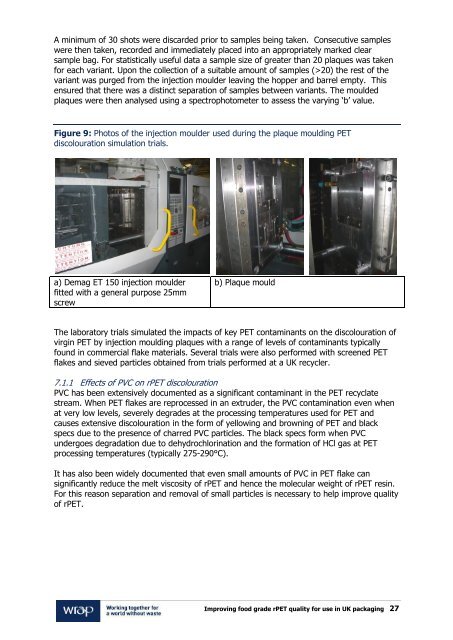rPET Quality Report
Create successful ePaper yourself
Turn your PDF publications into a flip-book with our unique Google optimized e-Paper software.
A minimum of 30 shots were discarded prior to samples being taken. Consecutive samples<br />
were then taken, recorded and immediately placed into an appropriately marked clear<br />
sample bag. For statistically useful data a sample size of greater than 20 plaques was taken<br />
for each variant. Upon the collection of a suitable amount of samples (>20) the rest of the<br />
variant was purged from the injection moulder leaving the hopper and barrel empty. This<br />
ensured that there was a distinct separation of samples between variants. The moulded<br />
plaques were then analysed using a spectrophotometer to assess the varying „b‟ value.<br />
Figure 9: Photos of the injection moulder used during the plaque moulding PET<br />
discolouration simulation trials.<br />
a) Demag ET 150 injection moulder<br />
fitted with a general purpose 25mm<br />
screw<br />
b) Plaque mould<br />
The laboratory trials simulated the impacts of key PET contaminants on the discolouration of<br />
virgin PET by injection moulding plaques with a range of levels of contaminants typically<br />
found in commercial flake materials. Several trials were also performed with screened PET<br />
flakes and sieved particles obtained from trials performed at a UK recycler.<br />
7.1.1 Effects of PVC on <strong>rPET</strong> discolouration<br />
PVC has been extensively documented as a significant contaminant in the PET recyclate<br />
stream. When PET flakes are reprocessed in an extruder, the PVC contamination even when<br />
at very low levels, severely degrades at the processing temperatures used for PET and<br />
causes extensive discolouration in the form of yellowing and browning of PET and black<br />
specs due to the presence of charred PVC particles. The black specs form when PVC<br />
undergoes degradation due to dehydrochlorination and the formation of HCl gas at PET<br />
processing temperatures (typically 275-290°C).<br />
It has also been widely documented that even small amounts of PVC in PET flake can<br />
significantly reduce the melt viscosity of <strong>rPET</strong> and hence the molecular weight of <strong>rPET</strong> resin.<br />
For this reason separation and removal of small particles is necessary to help improve quality<br />
of <strong>rPET</strong>.<br />
Improving food grade <strong>rPET</strong> quality for use in UK packaging 27



